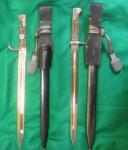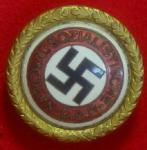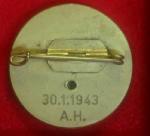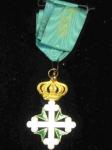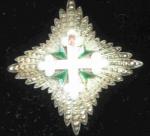-
Posts
102 -
Joined
-
Last visited
Content Type
Profiles
Forums
Blogs
Gallery
Events
Store
Everything posted by JoeW
-
Gordon, he looks almost out of place there. I can't really make out what the cap insignia is, but look at the rest of his uniform. Most all German military or government agencies like Reichsbahn, etc. used the box buckle I would think. He is wearing leather puttees. You don't think he might be Hungarian Gendarmerie or the other force wearing their gorget?
-
Double-breasted tailoring; no shoulder boards but collar tabs; seems almost like a over-jacket of some sort. NCO with a Zweidornschalle, so he wouldn't have a police sleeve eagle. The glare off the Ringkragen is maddening. Style appears like the Feldgendarmerie, Bahnhofswache and so forth, yet he appears to be wearing an earlier style Teller mutze.
-
The property markings found on M1929 Prussian police bayonets were fully identified for their police armories when marking the bayonets at issue or replacement and listed in their Service Manual 40a. Numerous books and online sites have reproduced this list for collectors. Here is such a site: http://www.radix.net/~bbrown/police_unit_marks.html . So it is not a matter of misunderstanding when it was pointed out that the markings really make no sense according to the service manual. No other police force used this style of bayonet except Prussia. And with the largest police force in Germany until the nationalization of police in 1936, this bayonet was adopted as the sidearm of the Ordnungspolizei. Markings were phased out by 1937. Not conforming to the basic guidelines of the service manual could mean a different things. The markings were applied by someone at that time who didn't read or care about the regulations. Perhaps he wanted his own shorthand. If you read about the 1932 markings in the above link, you will find that "S.P." indicated equipment assigned to the Schutzpolizei of the Administrative District of Potsdam. So perhaps after removing the crossguard and shortening everything, the armorer found he had defaced the original crossguard marking, so he remarked it but he was ignorant of the proper codes. The he also remarked or put a new top scabbard fitting on the scabbard and remarked it too. One can play out various scenarios to explain the odd marking. But it still comes down to having a very nice bayonet with markings that do not conform to the standards of the 1932 manual.
-
Ross, your description begs a lot of questions. You call it a shako star but it is affixed with four prongs, when police shako stars were usually attached by nuts on two threaded posts. Are the eight points in a full circle or are the points arrayed in a semi-circle? You describe it as aluminum, which was usually a post-war material used on shako stars. I think photos are needed.
-
Mervyn, your description is accurate.......with the addition of "...officially modified in length, new police eagle on grip and with the shell ornamentation removed form the cross guard." I picture here an unusual police blade side arm designated the P.S.s. - Polizei Seitengewehr sonderausfuhrung. Little is known of this service bayonet except that it was pictured in the police weapons manuals published until 1944 and described as being fashioned from a S.98/05 by narrowing the blade, applying the oakleaf relief to the pommel, adding horn grips with police insignia and providing a new steel scabbard. Those few in collection are sometimes found with numbers on the cross guard. There is no Prussian police acceptance found on the bayonet. They are made from standard WWI S.98/05s that were employed by many Weimar era state police forces as service bayonets. The approximate date of appearance in 1938/39. The factory providing the modification is thought to be Alcoso, because of similar markings found on scabbard springs in this model and in the "survival machete" produced by that company.
-
Mervyn, the dimensions of your bayonet are identical to my example of a converted M1929 with bayonet device. The acceptance markings are identical too. The only thing I do not understand is the markings on the crossguard and the upper scabbard fittings. These markings to not conform to the official 1932 Prussian police marking requirements. Either the markings were period made in ignorance of the official directives, or the markings are not original to the piece. The photo of the scabbard markings are a difficult to see actually as the scabbard is at an angle. So I can't comment on them. But in my opinion, the crossguard markings make no sense.
-
That sure is the *K acceptance mark of the Prussian police Mervyn. Yours is one of the reworked M1929 Prussian police Seitengewehrs. What is the blade length and total length of the bayonet. Does the scabbard have the *K marking on the back of the lower fitting? And what is its length? Thanks for this info.
-
Mervyn, I would be interested in knowing if your bayonet is Prussian in origin, or of III Reich vintage. Can you see any markings on the narrow spine of the blade at the cross-guard? The marking would be something like *k. That same marking would be on the lower scabbard fitting. That mark is the acceptance mark of the Prussian Police Beschaffungsamt (Procurement Depot) and is often found on these police bayonets with III Reich insignia on the grip plate.
-
Ivory was never specified in the service regulations, nor shown in any period catalogs showing "Extra" bayonets for private purchase.
-
The design of your bayonet (with eagle head pommel, horn grip plates and leather scabbard) originated for the Prussian police in 1929. Those style bayonets are by far the most found by collectors as the Prussian police force was by far the largest in Germany. The Prussian design bayonet was chosen by the Nazis as the design for their nationalized police in 1936. The Prussian police produced two hilt designs: with bayonet attachment and without. Those bayonets produced with bayonet attachment fittings were issued to members of the Schutzpolizei Bereitschaften (Protection Police Riot/Emergency Companies) while the other style were issued to all other members of the Schutzpolizei, the Landjagerei (rural police using brown color leather scabbards) and the Gemeindepolizei (using black color leather scabbards like the Schutzpolizei). After 1936, the Prussian style was adopted for police in all the Laender of Germany with the III Reich police insignia being installed on the grips. In 1938/39 the original long style Prussian bayonets were supposed to be shortened with the famous clamshell removed. This was not always accomplished. This style of bayonet was continued in production until 1940/41. This was always considered a standard service issue bayonet and was worn on duty and for special occasions by the Prussians. After the Nazi conversions, police parade regulations stipulated that the S.84/98 bayonet was to be worn, not this service bayonet. Here are examples of the three lengths of Prussian/Nazi conversion bayonets that can be encountered by collectors: the unshortened variation on the left, the standard shortened police bayonet and the shorter private purchase (Extra) side arm authorized for "Walking Out Dress"-off duty. Note that all still retain their distinctive clam shells that were ordered removed by police authorities, but apparently escaped the police armorers. I don't recognize off hand the markings on your bayonet. I cannot find it listed in the standard lexicon of Prussian Police markings issued in 1932.
-
Here are two bars that belonged to SS OGF Fritz Weitzel showing pre- and post- NSDAP DAZ presentation. The green ribbons with gold crowns indicated the level of the Italian Order of Sts. Maurice and Lazarus that he received during a trip to Rome. There were also in the Nachlass, two other ribbob bars of the "smooth style" with 10 & 15 ribbons as well as the entire ribbon bar and Italian orders. Was there terms for the two style of ribbon application on ribbon bars: ruffled and smooth?
-
Did anyone ever have a chance to examine the "gold" RPT badge (I forget if '33 or what) that was alleged to have been owned by Hitler. Or even remember it? It was on display at one of the earlier Max Shows in Pittsburgh. Quite a big production with multi-color glossy brochure. I have it around here somewhere.
-
Stan, do you notice how Kunstmann's right breast pocket is pushed out, while the left one seems to have slack in it with the pocket flap pushing out? It appears the pin is holding on to something and is the front of the pocket is not free of the rear which would be the case if the button hole mount was in use? I think the brooch pin is being used and is attached to the material inside the pocket, holding the outside closer to the body. Just my thoughts.
-
Stan, I must apologize for rudely forgetting about this thread. Following too many forums has its price- forgetfulness. Here is a post of the A.H. 30mm with brooch pin attachment as you requested. Do you and Bob have a copy of the published page listing Kunstmann as a recipient of the Golden Ehrenzeichen d. NSDAP?
-

Italy - Order of St. Maurice & Lazarus
JoeW replied to Noor's topic in Southern European & Balkan States
-

Italy - Order of St. Maurice & Lazarus
JoeW replied to Noor's topic in Southern European & Balkan States
-
From my files I find that in addition to the original decree of the Party Long Service Medals, there were at least nine (9) Ausfuhrungsbestimmungen expanding on the original decree. Did the March decree you mentioned above refer to the awarding of the party long service to qualified PLs that died in combat or from air raids?


